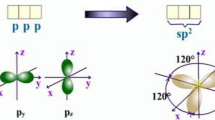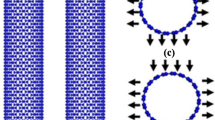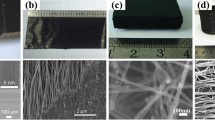Abstract
A meshless atomic-scale computational method was developed by taking account of structural dynamic evolution, such as atomic bond breakage and regeneration. This method, based on energy minimization, is an extension of B. Liu et al.’s atomic-scale finite element method (AFEM). The proposed method is faster than the standard conjugate gradient method and AFEM and can thus significantly save computational time especially in studying large-scale problems. The bond breakage of single-wall carbon nanotubes was studied.
Similar content being viewed by others

References
J. Fish, Journal of Nanoparticle Research, 8(5) (2006), pp. 577–594.
F.F. Abraham, Proceedings of the National Academy of Sciences of the United States of America, 99(9) (2002), pp. 5777–5782.
F.F. Abraham et al., Proceedings of the National Academy of Sciences of the United States of America, 99(9) (2002), pp. 5783–5787.
G.E. Moore, “Cramming More Components onto Integrated Circuits” (reprinted from Electronics, 19 April 1965, pp. 114–117), Proceedings of the IEEE, 86(1) (1998), pp. 82–85.
D.W. Brenner et al., Journal of Physics: Condensed Matter, 14(4) (2002), pp. 783–802.
D.W. Brenner, Physical Review B, 42(15) (1990), pp. 9458–9471.
M. Arroyo and T. Belytschko, Journal of the Mechanics and Physics of Solids, 50(9) (2002), pp. 1941–1977.
W.A. Curtin and R.E. Miller, Modelling and Simulation in Materials Science and Engineering, 11(3) (2003), pp. R33–R68.
S. Curtarolo and G. Ceder, Physical Review Letters, 88(25) (2002), p. 4.
W.N.E. and Z.Y. Huang, Physical Review Letters, 8713(13) (2001), p. 4.
S. Kohlhoff, P. Gumbsch, and H.F. Fischmeister, Philosophical Magazine a-Physics of Condensed Matter Structure Defects and Mechanical Properties, 64(4) (1991), pp. 851–878.
H. Rafii-Tabar, L. Hua, and M. Cross, Journal of Physics-Condensed Matter, 10(11) (1998), pp. 2375–2387.
R.E. Rudd and J.Q. Broughton, Physica Status Solidi B-Basic Research, 217(1) (2000), pp. 251–291.
G.J. Wagner and W.K. Liu, Journal of Computational Physics, 190(1) (2003), pp. 249–274.
W. Yang, H.L. Tan, and T.F. Guo, Modelling and Simulation in Materials Science and Engineering, 2(3A) (1994), pp. 767–782.
D. Qian, G.J. Wagner, and W.K. Liu, Computer Methods in Applied Mechanics and Engineering, 193(17–20) (2004), pp. 1603–1632.
W.K. Liu et al., Computer Methods in Applied Mechanics and Engineering, 195(13–16) (2006), pp. 1407–1421.
S.Q. Tang, T.Y. Hou, and W.K. Liu, Journal of Computational Physics, 213(1) (2006), pp. 57–85.
H.S. Park, E.G. Karpov, and W.K. Liu, International Journal for Numerical Methods in Engineering, 64(2) (2005), pp. 237–259.
H. Kadowaki and W.K. Liu, CMES-Computer Modeling in Engineering & Sciences, 7(3) (2005), pp. 269–282.
S.L. Zhang et al., International Journal for Numerical Methods in Engineering, 70(8) (2007), pp. 913–933.
S.L. Zhang et al., Physical Review B, 71(11) (2005), p. 12.
S.P. Xiao and T. Belytschko, Computer Methods in Applied Mechanics and Engineering, 193(17–20) (2004), pp. 1645–1669.
V.B. Shenoy et al., Journal of the Mechanics and Physics of Solids, 47(3) (1999), pp. 611–642.
R. Miller et al., Engineering Fracture Mechanics, 61(3–4) (1998), pp. 427–444.
V.B. Shenoy et al., Physical Review Letters, 80(4) (1998), pp. 742–745.
L.E. Shilkrot, W.A. Curtin, and R.E. Miller, Journal of the Mechanics and Physics of Solids, 50(10) (2002), pp. 2085–2106.
E.B. Tadmor, R. Phillips, and M. Ortiz, Langmuir, 12(19) (1996), pp. 4529–4534.
E.B. Tadmor, M. Ortiz, and R. Phillips, Philosophical Magazine a-Physics of Condensed Matter Structure Defects and Mechanical Properties, 73(6) (1996), pp. 1529–1563.
M. Born and K. Huang, Dynamical Theory of the Crystal Lattices (Oxford: Oxford University Press, 1954).
B. Liu et al., Physical Review B, 72(3) (2005), p. 8.
B. Liu et al., Computer Methods in Applied Mechanics and Engineering, 193(17–20) (2004), pp. 1849–1864.
M.F. Yu et al., Science, 287(5453) (2000), pp. 637–640.
Author information
Authors and Affiliations
Corresponding author
Rights and permissions
About this article
Cite this article
Feng, X., Jiang, H., Huang, Y. et al. Modeling fracture in carbon nanotubes using a meshless atomic-scale finite-element method. JOM 60, 50–55 (2008). https://doi.org/10.1007/s11837-008-0049-4
Published:
Issue Date:
DOI: https://doi.org/10.1007/s11837-008-0049-4



